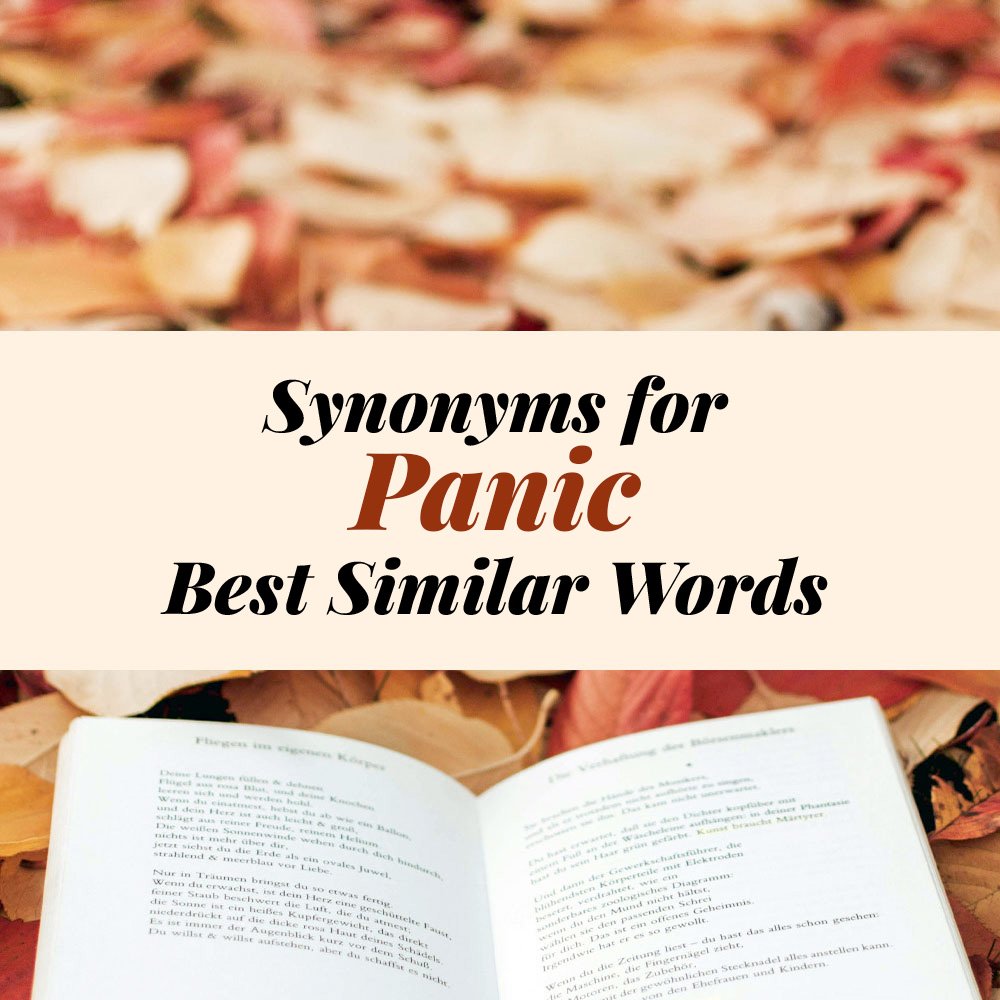Feeling panic is something everyone experiences at times. It can happen when we are scared, worried, or surprised by sudden events. There are many words similar to panic, such as alarm, fear, and fright. In this article, we will explore 15 different words you can use instead of panic with helpful examples.
| Synonym | Example |
|---|---|
| Alarm | The loud siren caused great alarm among the residents. |
| Fear | She felt a deep fear before speaking on stage. |
| Fright | The sudden noise gave the cat a big fright. |
| Hysteria | The crowd fell into hysteria when the news broke. |
| Anxiety | He felt anxiety before the important exam. |
| Dread | She approached the dentist with dread. |
| Terror | The horror movie filled him with terror. |
| Trepidation | He entered the dark room with trepidation. |
| Alarmism | The news report caused unnecessary alarmism. |
| Consternation | His sudden resignation caused consternation in the office. |
| Apprehension | She felt apprehension about the upcoming journey. |
| Shock | The shocking event left everyone in shock. |
| Distress | He was in deep distress after losing his wallet. |
| Unease | A feeling of unease came over her during the meeting. |
| Panic | The passengers were in full panic when the plane turbulence started. |
15 Different Ways to Say PANIC: Another Word for Panic
Alarm
Alarm is a word used when someone feels sudden fear or worry. It often appears in situations that need quick attention. Alarm is helpful to show urgency and the need to act fast. It can describe reactions to emergencies, loud noises, or unexpected events. Using alarm conveys both emotional and practical response to fear. It is very effective in writing or conversation when you want to show strong, sudden concern.
- The fire alarm caused everyone to run outside.
- His strange behavior raised alarm among friends.
- The loud noise set off an alarm in the building.
- Seeing the storm approaching filled her with alarm.
Fear
Fear is a strong emotion felt when someone is in danger or worried about something bad. It can describe small daily worries or very serious threats. Fear helps people understand how nervous or scared someone feels. It is widely used in storytelling, conversation, and explanations of emotions. Using fear makes your sentences more relatable because everyone experiences fear at some point. Fear can last a short time or continue over days depending on the situation.
- She has a fear of heights.
- He spoke with fear in his voice.
- The child showed fear when meeting a dog.
- I have fear of failing my test.
Fright
Fright is a sudden and strong feeling of fear. It usually happens unexpectedly and passes quickly. Fright is often caused by loud noises, sudden movements, or surprises. You can use fright to describe someone jumping, screaming, or feeling shocked in a short moment. Fright helps make stories or descriptions exciting because it shows a quick reaction to danger or surprise. It is perfect for small, intense moments of fear that happen suddenly.
- The loud bang gave him a fright.
- She jumped in fright at the noise.
- The ghost story caused a fright for the kids.
- I got a fright when I saw a snake.
Hysteria
Hysteria is extreme fear that spreads quickly, often in groups. It occurs when people lose control because of panic. Hysteria is used when emotions are very high, and reactions are exaggerated. It often happens in emergencies, large crowds, or shocking news situations. Hysteria describes fear that is contagious and overwhelming. Using hysteria shows the intensity of a situation and how strong emotions can affect people in unexpected ways. It emphasizes both panic and social reaction.
- The movie caused hysteria among fans.
- During the fire, people fell into hysteria.
- The news of the accident led to hysteria in the city.
- She laughed in hysteria after hearing the joke.
Anxiety
Anxiety is a feeling of worry about what might happen in the future. It is usually slower than panic and can last a long time. Anxiety is often connected to nervousness, tension, and stress. It can happen before exams, interviews, or new experiences. Using anxiety helps show ongoing concern rather than sudden fear. It is a useful word to describe both mental and emotional reactions to uncertainty or danger. Anxiety helps readers understand internal feelings clearly.
- He had anxiety before the interview.
- Waiting for results caused her anxiety.
- Public speaking brings him anxiety.
- She felt anxiety about moving to a new city.
Dread
Dread is a strong feeling of fear about something that will happen. It is heavy and often feels difficult to handle. Dread is used when someone anticipates something very unpleasant or stressful. It can describe fear before exams, disasters, or bad news. Using dread helps convey seriousness and emotional weight in writing. It shows that the person is aware of danger or unpleasant events and cannot avoid feeling afraid.
- She faced the dentist with dread.
- He felt dread before the storm.
- The thought of exams filled him with dread.
- I have dread when I remember that day.
Terror
Terror is an extreme form of fear. It is very intense and often sudden. Terror is best used in dangerous, life-threatening, or shocking situations. It shows the highest level of fear and can lead to strong physical reactions like running, screaming, or freezing. Using terror communicates the most serious form of panic and helps the reader feel the danger someone faces. Terror is often used in stories, movies, or real-life situations where fear is overwhelming.
- The haunted house filled him with terror.
- She screamed in terror at the sight.
- The dog barked in terror at the stranger.
- He ran in terror from the fire.
Trepidation
Trepidation is worry mixed with fear before doing something. It is usually calm but shows nervousness or hesitation. Trepidation works well when someone is cautious about new situations or challenges. It describes fear that is controlled rather than wild panic. Using trepidation helps explain careful or slow reactions. It is a polite word that shows uncertainty and mental preparation for a potentially scary or difficult event.
- He entered the room with trepidation.
- She approached the stage in trepidation.
- The team walked into the challenge with trepidation.
- He felt trepidation before meeting his boss.
Alarmism
Alarmism is when fear is spread too quickly or too much. It often happens through exaggerated warnings or rumors. Alarmism causes people to react in panic even when danger is not immediate. Using alarmism helps explain situations where fear is not always justified. It is useful for describing media, public warnings, or false rumors that increase worry. Alarmism shows that fear can be contagious and sometimes unnecessary, giving a strong social and emotional impact.
- The report was full of alarmism.
- Her stories caused alarmism in the town.
- Some news spreads alarmism every day.
- He warned against alarmism during the crisis.
Consternation
Consternation is a mix of surprise and fear. It occurs when something shocking or upsetting happens. Consternation is often combined with confusion and helplessness. It is used to show how unexpected events can disturb people. Using consternation highlights both emotional shock and mental worry. It is effective for describing reactions to bad news or sudden problems. Consternation shows a deeper level of fear that involves mental disturbance and unease.
- His sudden resignation caused consternation in the office.
- The mistake led to consternation among the team.
- She faced consternation after hearing the news.
- The delay caused consternation for passengers.
Apprehension
Apprehension is worry before something happens. It combines nervousness, concern, and fear of possible danger. It is best used for anticipation of uncertain events. Apprehension helps describe hesitation, doubt, or reluctance in approaching challenges. Using apprehension makes the situation more relatable by showing internal thought and caution. It is effective for both small and serious situations where fear and worry are present.
- She felt apprehension about the journey.
- He entered the room with apprehension.
- The meeting filled him with apprehension.
- I had apprehension before the test.
Shock
Shock is sudden surprise combined with fear or worry. It happens when unexpected events happen quickly. Shock can affect both emotions and physical reactions. Using shock is ideal to describe moments when people feel overwhelmed or stunned. It is useful for accidents, bad news, or sudden revelations. Shock communicates both immediate panic and emotional impact.
- The accident left everyone in shock.
- She was in shock after hearing the news.
- The announcement caused shock among the students.
- He felt shock at the unexpected event.
Distress
Distress is a strong emotional reaction to fear, worry, or sadness. It often happens when someone faces a problem or loss. Distress can show both mental and physical struggle. Using distress helps readers understand serious emotional pain or urgent concern. It is effective for describing personal situations, accidents, or emergencies. Distress communicates fear that is deeper, longer-lasting, and more emotional than panic alone.
- He was in deep distress after losing his wallet.
- The news caused distress among the family.
- She felt distress after the argument.
- The patient showed signs of distress.
Unease
Unease is a mild feeling of fear or worry. It happens when someone feels uncomfortable, nervous, or uncertain. Unease is often subtle and builds slowly. Using unease helps explain tension, discomfort, or suspicion in situations. It is suitable for social settings, small worries, or anticipatory fear. Unease makes readers understand ongoing worry without strong panic, showing emotions that are quiet but present.
- A feeling of unease came over her during the meeting.
- He felt unease in the crowded room.
- The silence created unease among them.
- She walked home with unease after the argument.
Panic
Panic is sudden and overwhelming fear. It makes people act quickly, often without thinking. Panic is used in emergencies, dangerous situations, or unexpected events. It is the most direct and intense expression of fear. Using panic shows strong reactions, urgency, and lack of control. Panic is helpful for writing, storytelling, or describing real-life experiences where fear dominates thought and action.
- The passengers were in full panic when turbulence started.
- She ran in panic from the burning building.
- The announcement caused panic in the crowd.
- He felt panic after losing his keys.

Final Thoughts
Using these 15 synonyms for panic allows you to describe fear in many ways. Each word adds unique meaning, context, and emotion. Choosing the right word helps make writing more vivid and expressive, making fear understandable in different situations.








